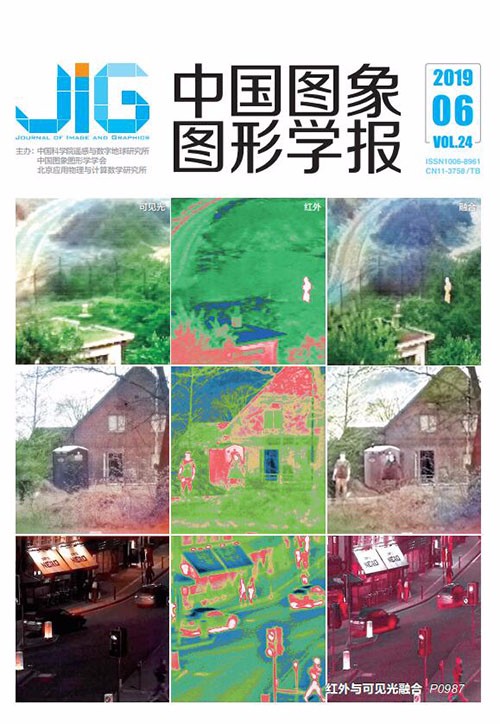
综合边界和纹理信息的合成孔径雷达图像目标分割
谌华1,2,3, 郭伟1,2, 闫敬文4(1.中国科学院微波遥感技术重点实验室, 北京 100190;2.中国科学院国家空间科学中心, 北京 100190;3.中国科学院大学, 北京 100049;4.汕头大学, 汕头 515063) 摘 要
目的 针对传统Grab Cut算法需要人工交互操作,无法实现合成孔径雷达(SAR)图像的自动分割,且方式单一(仅利用边界或纹理信息中的一种)的问题,提出一种综合利用边界和纹理信息的改进Grab Cut算法,实现对SAR图像目标的自动分割。方法 首先将其他格式的彩色或灰度SAR图像转化为24 bit的位图,采用图形理论对整幅SAR图像建模,根据最大流算法找到描述图的能量函数最小的割集,从而分割出目标区域;然后采用中值滤波抑制相干噪声;最后通过邻域生长算法滤除图像斑点和小目标的干扰,从而达到目标边界的连接,实现自动对SAR图像中的目标进行分割。结果 在64位Window 7环境下采用MATLAB R2014处理平台,对楼房、车库、大树、汽车群等4幅分辨率不同的SAR图像进行目标分割实验,特征目标被自动分割出来,耗时分别为1.69 s、1.58 s、1.84 s和3.09 s,相比Mean-shift和Otsu算法,平均计算效率分别提升150%和3%,并且图像中的背景杂波、目标阴影和干扰小目标均被有效去除。结论 综合利用边界和纹理信息能够有效抑制相干噪声,去除图像斑点和小目标的干扰,从而达到目标边界的连接,实现对SAR图像目标的自动分割。实验结果表明,本文算法可以满足工程化应用要求,自适应性强,分割精度高,且具有较好的鲁棒性。
关键词
Synthetic aperture radar image target segmentation methodbased on boundary and texture information
Chen Hua1,2,3, Guo Wei1,2, Yan Jingwen4(1.Key Laboratory of Microwave Remote Sensing, Chinese Academy of Sciences, Beijing 100190, China;2.Center for Space Science and Applied Research, Chinese Academy of Sciences, Beijing 100190, China;3.University of Chinese Academy of Sciences, Beijing 100049, China;4.Shantou University, Shantou 515063, China) Abstract
Objective Synthetic aperture radar (SAR) systems are widely applied in many areas, such as civil and mili-tary fields, because they can operate day and night under various weather conditions. As a key and basic section of target recognition and interpretation for SAR images, SAR image segmentation has received much attention in recent years. However, SAR images suffer from strong speckle noise due to the influence of coherent illumination, which makes target segmentation in images difficult. Considering the importance of SAR image segmentation, this study proposes to segment the targets of a SAR image automatically. Many algorithms can solve SAR image target segmentation, and one of these is the GrabCut algorithm. The GrabCut algorithm, which is based on graph theory, achieves optimal segmentation and transforms the image segmentation problem into a problem of computing the maximum flow in the flow network. After this transformation, the problem can be solved with the min-cut or max-flow method. Nevertheless, the GrabCut algorithm has crucial deficiencies; for example, it not only requires artificial interaction but also merely utilizes one of the following:information, texture, or boundary information in the images. To improve such deficiencies, this study uses two kinds of information, namely, texture and boundary, for utilization in SAR images and for achieving automatic target segmentation. Method The proposed algorithm involves several steps. First, the proposed algorithm transforms a colored or gray SAR image into a 24-bit bitmap that contains substantial SAR image information. Second, with the aid of the 24-bit bitmap, a SAR image model is built according to graph theory. The model is a Gaussian mixed model that assigns each pixel in SAR images into three types of chroma spaces. Under the model framework, the energy function of the minimized description diagram is generated. Third, to segment the target region in the SAR image, the max-flow method is applied to determine the smallest cut set of the energy function in the description diagram. Coherent noise has a serious impact on image segmentation; thus, the proposed algorithm utilizes the median filter method to reduce noise in the target region and achieve precise SAR image target segmentation. Lastly, one of main problems in segmentation is that the interference of SAR image spots and small objects leads to incorrect targets during target segmentation. The neighborhood growth method, which removes specks in the SAR image target region and filters out small targets, is applied to tackle this problem and connect the target boundary. Through these steps, SAR image target segmentation can be performed automatically. Result Several state-of-the-start image segmentation algorithms, including mean-shift and Otsu segmentation algorithms, are compared with the proposed algorithm to validate its superiority. All experiments are performed in the processing platform of MATLAB R2014 in a 64-bit Windows 7 environment. In the first experiment, four different SAR images involving buildings, garages, trees, and cars are tested for image target segmentation. Results show that the proposed algorithm can segment many useful characteristics in the targets and can effectively remove background clutter, target shadows, and small interfering targets in the tested SAR images. This capability demonstrates that the proposed algorithm performs well in SAR image segmentation. A second experiment is conducted to illustrate the performance of the proposed algorithm. Here, mean-shift and Otsu segmentation algorithms and the proposed algorithm are simultaneously tested using four SAR images. As shown in the figures and tables, the proposed algorithm exhibits the best performance in SAR image target segmentation among all of the tested algorithms. The mean-shift algorithm can segment SAR image targets, but the contour boundary of the targets is fuzzy, and the computational efficiency is low. The Otsu segmentation algorithm can hardly segment targets correctly. Meanwhile, the proposed algorithm can split image targets accurately and reduce the computation time. Conclusion One of the most common methods of SAR image target segmentation is the GrabCut algorithm. However, GrabCut's precision of target segmentation is considerably affected by image background clutter and coherent noise. Meanwhile, targets in SAR images are often shielded, resulting in inaccurate image segmentation results. To address these problems, the proposed algorithm builds a Gaussian mixed model then transforms the target segmentation problem into a problem of minimizing the energy function of the description diagram. The max-flow method is used to determine the smallest cut set. The proposed algorithm can segment SAR image targets accurately through multiple iterations of the max-flow method in the SAR image color space domain and by using a median filter to remove specks in the SAR image target region and filter out small targets. However, the model in the proposed algorithm is not adaptive and thus cannot perform well in target segmentation of various SAR images. Moreover, the proposed algorithm applies the max-flow method to compute the max flow in the description diagram, thus spending considerable time in searching. In the future, we will further improve the precision of target segmentation by using an adaptive Gaussian mixed model and several useful approaches for computing the max flow to improve the performance of SAR image target segmentation.
Keywords
|



 中国图象图形学报 │ 京ICP备05080539号-4 │ 本系统由
中国图象图形学报 │ 京ICP备05080539号-4 │ 本系统由